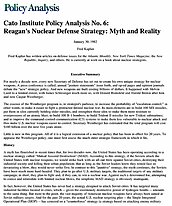For nearly a decade now, every new Secretary of Defense has set out to create his own unique strategy for nuclear weapons. A press conference is called, annual “posture statements” issue forth, and op-ed pages and opinion journals debate the “new” strategic policy. And new weapons are built costing billions of dollars. It happened with Melvin Laird to a limited extent, with James Schlesinger much more so, with Donald Rumsfeld and Harold Brown after him and now Caspar Weinberger.
The essence of the Weinberger program is, in strategist’s parlance, to increase the probability of “escalation control;” in other words, to make it easier to fight a protracted limited nuclear war. Its main elements are to build 100 MX missiles, put them in silos currently holding older missiles, and strengthen those silos to make them more resistant to overpressures of an atomic blast; to build 100 B‑1 bombers; to build Trident II missiles for new Trident submarines; and to improve the command-control-communication (C3) systems to make them less vulnerable to nuclear attack and thus make U.S. nuclear weapons easier to control. Secretary Weinberger has estimated that the total program will cost $180 billion over the next five years alone.
Little is new in this program. All of it is a logical extension of a nuclear policy that has been in effect for 20 years. To appraise the Weinberger policy, one must first assess the much older strategic framework in which it fits.
About the Author

This work is licensed under a Creative Commons Attribution-NonCommercial-ShareAlike 4.0 International License.
